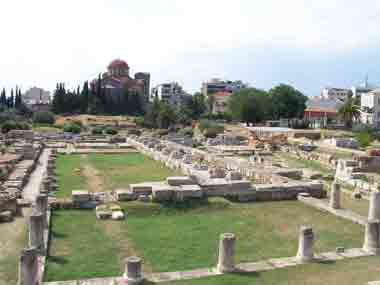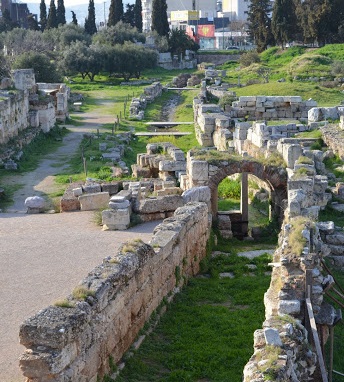
Kerameikos Cemetery

Brief Overview
Keramikos is an area of Athens, Greece, located to the northwest of the Acropolis, which includes an extensive area both within and outside the ancient city walls, on both sides of the Dipylon Gate and by the banks of the Eridanos River.
It was the potters' quarter of the city, from which the English word "ceramic" is derived, and was also the site of an important cemetery and numerous funerary sculptures erected along the road out of the city towards Eleusis.
The area took its name from the city square or demos of the Kerameis, which in turn derived its name from the word keramos, "pottery clay", from which the English word "ceramic" is derived).
The "Inner Kerameikos" was the former "potters' quarter" within the city and "Outer Kerameikos" covers the cemetery and also the Dimosion Sima (public graveyard) just outside the city walls, where Pericles delivered his funeral oration in 431 BC.
The cemetery was also where the Hiera Hodos (the Sacred Way, i.e. the road to Eleusis) began, along which the procession moved for the Eleusinian Mysteries.
The quarter was located there because of the abundance of clay mud carried over by the Eridanos River.

In Detail
Kerameikos, the Cemetery of Ancient Athens
Kerameikos is one of the most important but least visited archaeological sights in Athens. This was actually the cemetery of ancient Athens and was continuously in use from the 9th century BC until the Roman times. The area took its name from "keramos", which means pottery in Greek, from the numerous pottery workshops that existed in the area before it was turned into a cemetery.
Another explanation is that the area took its name from the local hero Keramos, son of Dionysus and Ariadne. The region of Kerameikos was divided in two parts by the walls of Athens, the so-called Themistoclean walls. The inner part was an inhabited area, while the outer part was actually the cemetery, which laid outside the city walls. The walls had two gates, Dipylon and the Sacred Gate.
Dipylon was the gate of the Panathenaic Way which led to the Acropolis and the Sacred Gate led to Eleusina, an important town in the ancient times, where the Eleusinian Mysteries would take place every autumn. In the Classical times, a significant public building, the Pompeion, was constructed between the two gates. This building was the starting point for the long procession of the Panathenaic Festival, the most important festival in ancient Athens in honor of goddess Athena, the protector of the town.
Before the procession, a large sacrifice of 100 cows would take place there. This building was destroyed during the siege of Athens by Sullas, a Roman general, in 86 BC. Archaeological excavations in Kerameikos started in 1870. From 1913 till present, the excavations are undertaken by the German Archaeological Institute of Athens. Archaeologists have found columns of temples, marble statues, remains of public buildings, funeral offerings and thousands of tombs. In fact, during the works of Kerameikos Metro Station, 1,000 more tombs were found dating from the 5th and the 4th century BC. The archaeological site of Kerameikos is located at the end of Ermou street, on the north west of the Acropolis. A small museum with interesting findings is located next to the entrance of the site.
[1]
Official Website and Map
Further Sources
[1] "Greeka"
"Athens Walker"
"Kerameikos, Ergebnisse Der Ausgrabungen"
Our Mobile Application
Check out Our Mobile Application "Ancient Greece Reloaded"


